
The Narwhal’s in-depth environmental reporting earns 11 national award nominations
From disappearing ice roads to reappearing buffalo, our stories explained the wonder and challenges of...
Two summers ago, biologist Cori Lausen was searching for highly endangered northern myotis bats near Revelstoke, British Columbia. The bats, which weigh little more than a loonie, look as fluffy as rabbits and have long, dark ears. Lausen and her team members slowly made their way up the heavily logged Columbia River Valley. Each evening as the sun set, once birds had settled into their nests for the night, they strung nets and waited. They caught and released a few bats, but not a single northern myotis.
On the shores of the Kinbasket hydro reservoir, about 160 kilometres north of Revelstoke, Lausen and her team decided to make one last attempt. They walked across a causeway to a small island in the reservoir and placed their nets. Almost immediately, they caught a northern myotis.
The light-brown bat was a juvenile female, which indicated the species — dependent on old-growth trees — was reproducing in the area. Northern myotis bats roost and raise their pups in crevices under the thick, sloughing bark of old trees. Dozens of females congregate in larger crevices, taking turns to guard each other’s babies while colony members forage for insects like mosquitoes and spongy moths (formerly called gypsy moths). Lausen, director of bat conservation for the Wildlife Conservation Society Canada, wondered if the species might have somehow adapted to roost in young trees after most of the region’s old-growth inland temperate rainforest disappeared.
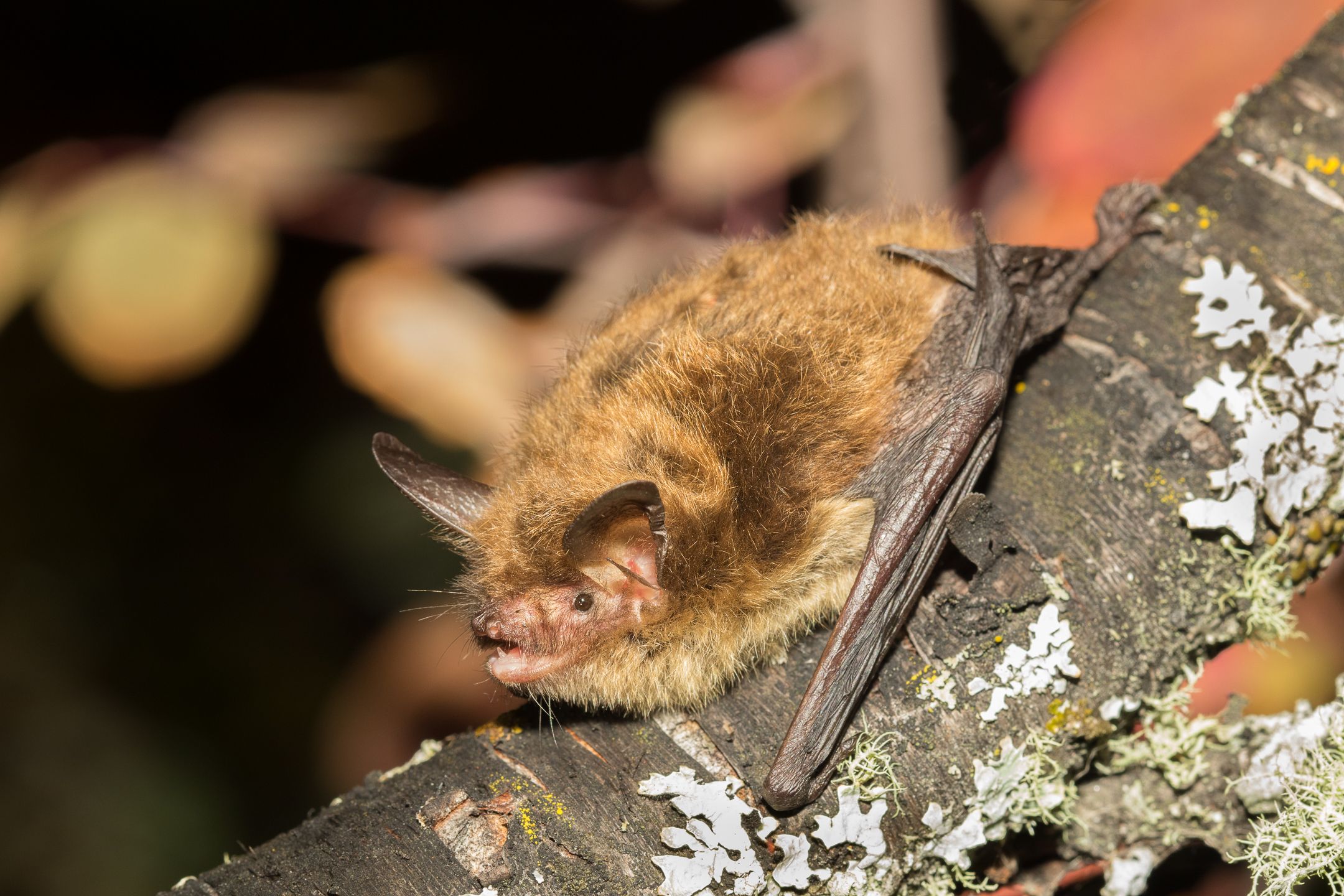
She shaved off a tiny area between the bat’s shoulders. Using non-toxic surgical adhesive glue, she stuck on a teeny transmitter, hoping the bat would lead biologists to its maternal roost. The bat flew away, over the reservoir. That surprised Lausen; it was unusual for a northern myotis to be out in the open where it could more easily be spotted by an owl or hawk.
The researchers walked around the island, listening to the transmitter’s ever-fainter beeps. It seemed the bat, smaller than Lausen’s hand, had flown clear across the reservoir. The next night, a volunteer with a boat ferried two researchers out onto the water. The transmitter led them to the reservoir’s far shore. They hiked about 100 metres through a second-growth forest and found a small, solitary grove of old-growth cedar and hemlock trees that was home to a northern myotis bat colony.
“Now we know how to find old-growth patches,” Lausen says. “You track this bat that is dependent on old-growth. It’s been an eye opener.”
Old-growth patches are all that’s left of most of B.C.’s rare inland temperate rainforest. The ancient rainforest, found in valley bottoms drenched with rain and snow, is home to giant trees normally associated with coastal places like the Great Bear Rainforest, Clayoquot Sound and Fairy Creek. Only in two other places in the world — Russia’s far east and southern Siberia — does a temperate rainforest grow so far from the sea.
A century ago, B.C. had an estimated 1.3 million hectares of inland temperate rainforest. Today, following decades of industrial logging and other disturbances — including flooding for hydro dams — fewer than 60,000 hectares of the core, old forest remain, according to researchers. A peer-reviewed study, published in the journal Land, found logging approvals in the inland temperate rainforest increased 40 per cent between 2020 and 2021 — even as the B.C. government promised to protect old-growth forests and at-risk ecosystems.
The study’s authors concluded ecosystem collapse in the inland rainforest, an area of rich biodiversity, was possible within nine to 18 years. That collapse has already begun: mountain caribou herds that depend on the rainforest for food and shelter are disappearing, while scientists are rushing to document rare lichen species before they are lost. With less than five per cent of the core rainforest remaining, the study’s authors noted “full protection of remaining primary forest is especially warranted.”
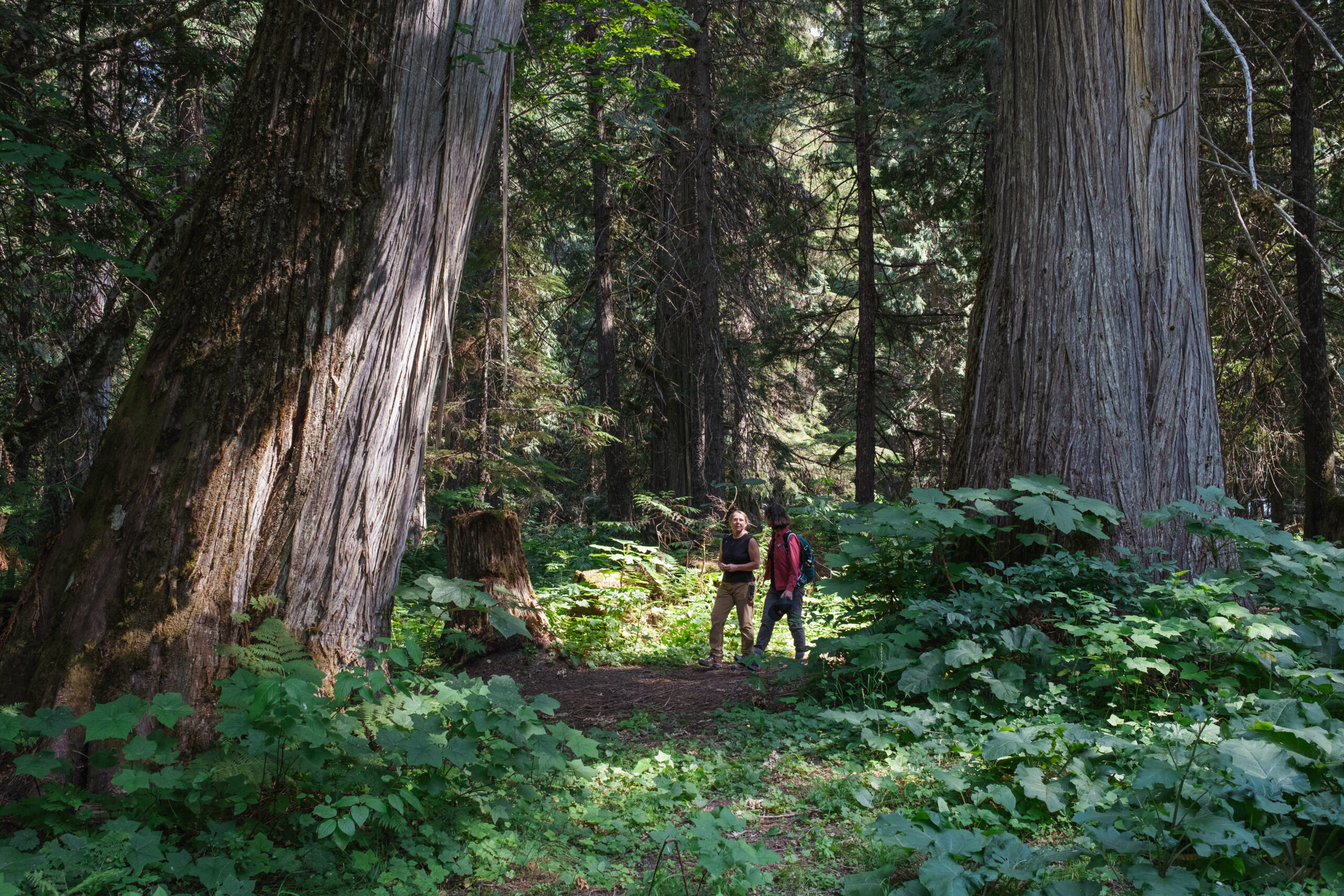

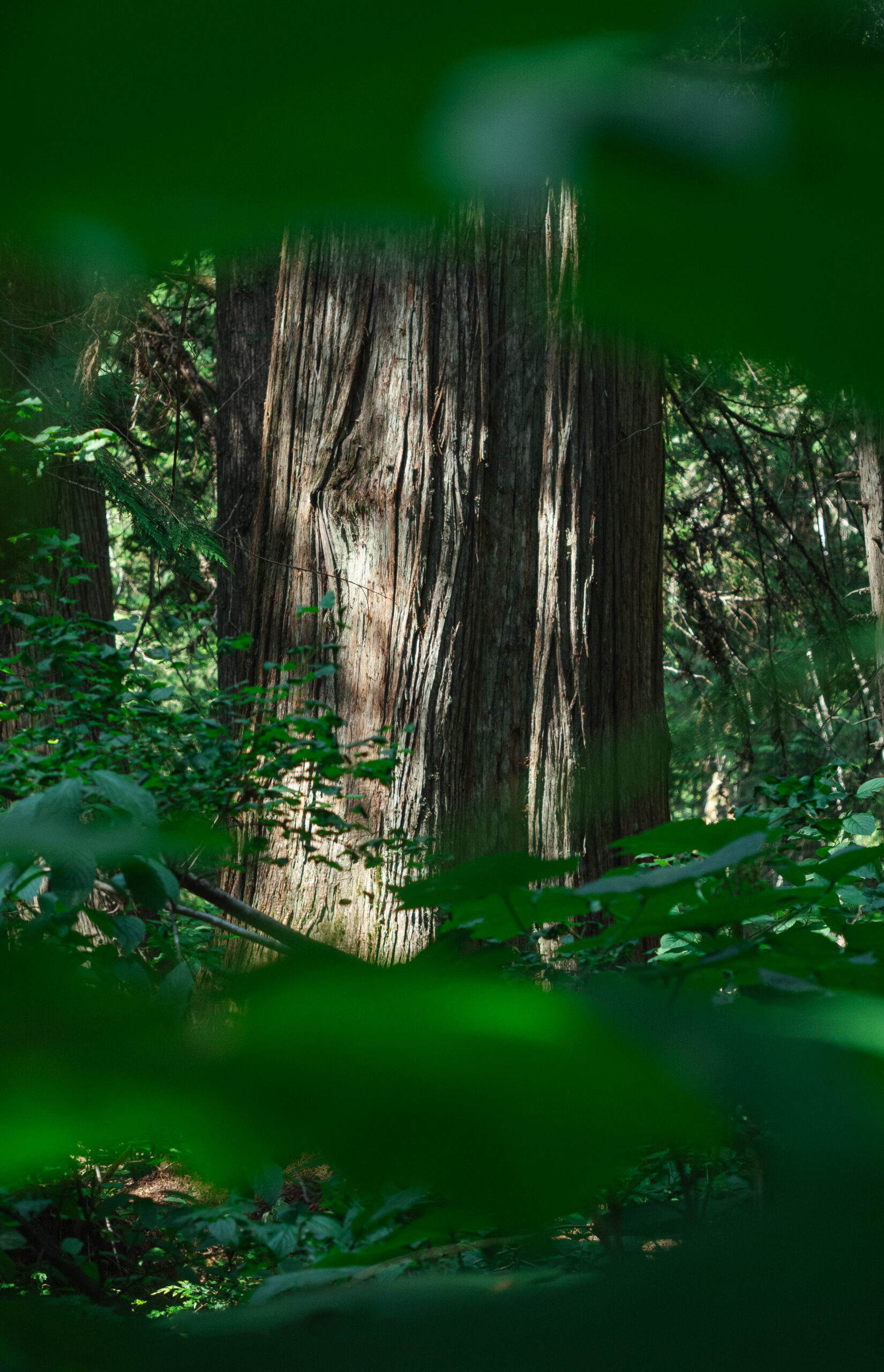
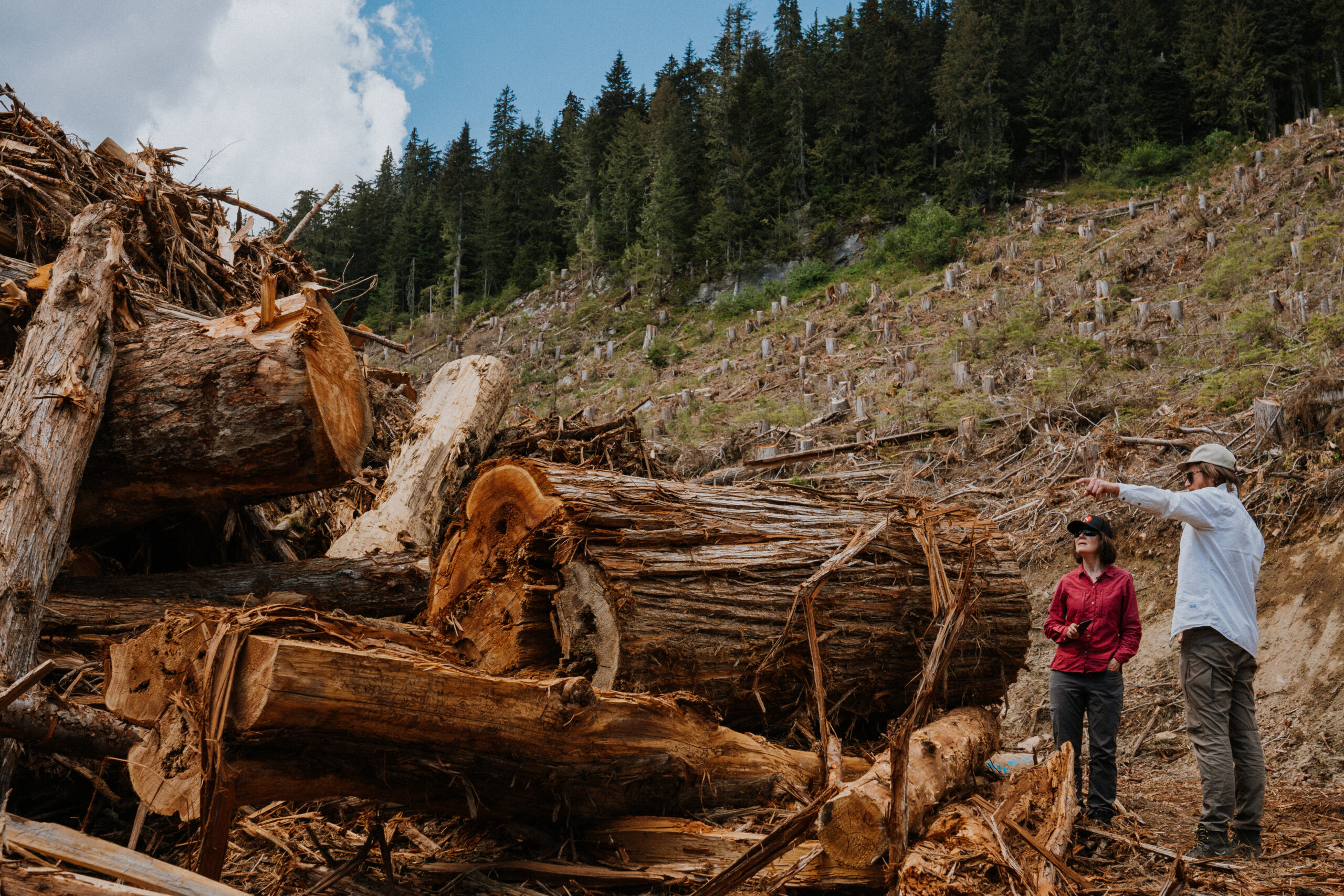
Northern myotis bats, which are federally listed as endangered, are found in many parts of Canada. They’ve been documented in different regions of B.C. According to the B.C. Conservation Data Centre, there’s a dearth of data on the size of the provincial population. Lausen says the bats’ inland temperate rainforest habitat is so badly eroded scientists aren’t sure how the bats are faring, or how successfully they’re able to reproduce in the region. “Are they still here?” she wonders. “Because if they’re still here, we should be trying to mitigate habitat loss.”
The bats need all the help they can get. A deadly fungal disease called white-nose syndrome is moving westward and north. The disease, which has killed millions of bats in North America, is expected to render some bat species extinct. Detected in bats in Washington and Alberta, it’s thought to be only a matter of time before it spreads in B.C. The fungus grows on the bats’ noses, wings and bodies, waking them up from hibernation so they often starve to death by spring.
To help northern myotis bats in the inland temperate rainforest, Lausen and her team decided to try making imitation old-growth trees. “This is really all about a stopgap measure,” Lausen explains. “This isn’t a solution in any way. This is really just trying to buy time until the rest of the trees catch up and start to create some of these natural crevices they need, that are just not available in younger forests regenerating after logging.”
On a blue-sky summer day, Lausen heads out to check on some of the fake old-growth. From Revelstoke, she drives south to a ferry that takes her across the Arrow Lakes reservoir. Travelling along a two-lane highway, toward a speck of a town called Beaton, she passes clear cuts and young, replanted forests. Lausen pulls off at a grassy track and parks a short distance from the highway in a clearing bright with wildflowers. The clearing is surrounded by scraggy young poplars, western hemlocks and thin Douglas firs with tangles of underbrush. “This whole area used to be a lovely forest,” Lausen says. “Over time, we’re just seeing less and less habitat available for bats to use.”

She points to a tree at the edge of the clearing. The trunk is about the height and diameter of a telephone pole. Following directions from Lausen’s team, a month earlier an arborist had lopped off all the branches, topped the tree and ringed it with a chainsaw to prevent sap from flowing. The aim is to force the newly killed tree into becoming a snag — natural bat-roosting habitat.
“I know it sounds weird, but literally we are killing trees because we’re trying to advance the production of snags,” says Lausen, who is wearing a necklace with a metal pendant in the shape of a bat.
Growing up south of Calgary, Lausen lived in an old house with a little brown bat colony in the attic. Sometimes, a pup found its way into the family’s living space. Lausen’s mother locked herself and the kids in the bathroom while her father killed the tiny intruder. Lausen wondered why adults were scared of something so small and “cute and fluffy.”
As a biology undergraduate student in Alberta, she worked on a bat research project. She was nipped on the hand by a big brown bat. “It was love at first bite,” she recalls. Most small mammal species have short lifespans and large litters, but the bat that bit her hand was older than Lausen. “Here are bats, living very old, having hardly any young, breaking all the rules. That was the eureka moment. … I just needed to know more about them. And I never looked back.”
At first glance, the branchless tree doesn’t look like anything special. But fastened to it is a yellow “Wildlife Tree” sign that says, “This tree has been modified for use by bats.” A sheaf of thick brown plastic, 1.3-metres long, wraps around the trunk some distance from the ground. The plastic, called BrandenBark, is open a few centimetres at the bottom, allowing bats to squeeze under. If bats need to warm up they can stay on the sunnier side. If they’re hot, they can crawl to the shadier side. “We’re basically starting off small, throwing confetti to the wind, seeing what works, what doesn’t work,” Lausen explains. The Wildlife Conservation Society had already installed imitation bark in other places in the Columbia River Basin, with some success: endangered little brown bats were using it for roosts.
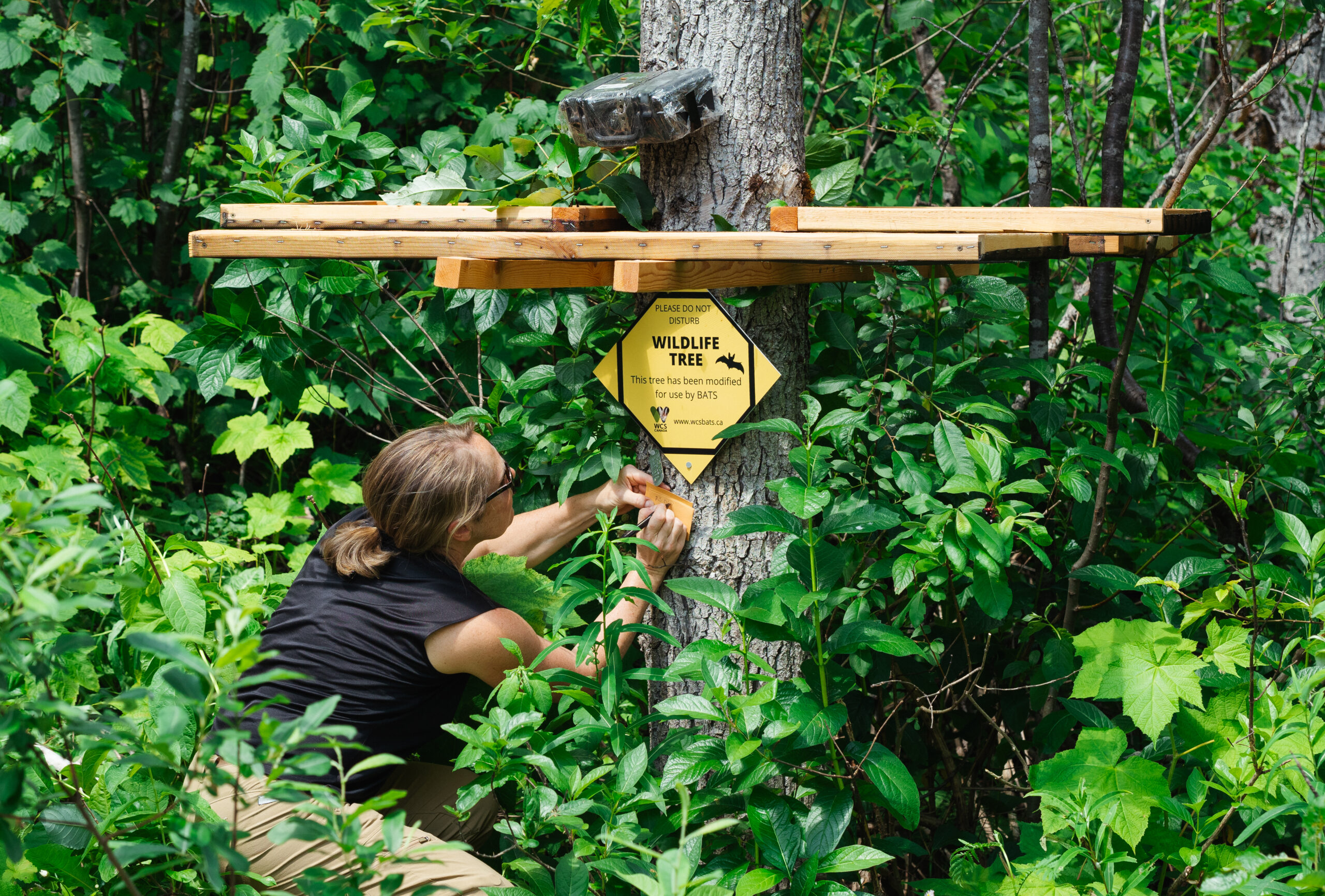
Attached to the wildlife tree trunk are four wood-framed trays with fine wire-mesh bottoms. Standing on her tiptoes, Lausen peers into a tray. With her index finger, she shuffles aside fir needles, white poplar fluff and crispy leaf fragments. “Oh yeah,” she says happily. “Bat guano.”
Three pieces of guano, or poop, each about the size of a grain of rice, are difficult to spot. They look like mouse droppings, only shinier from bits of iridescent insect wings. Lausen fetches a stepladder from her truck and leans it against the tree. She snaps on a pair of latex gloves. Then she climbs up the ladder and picks up a leaf fragment. With the concentration of a curling player about to win a game, she slowly sweeps the largest dropping into an envelope. “That’s a tiny little prize,” she says with satisfaction.
The two smaller droppings might be from California myotis bats, meaning there could be two species present. She’ll send the guano to a lab in Nelson, B.C., for DNA analysis, hoping it will indicate northern myotis, formerly known as long-eared bats, are already using the structure.
Directed by Lausen’s team, a chainsaw-wielding arborist had also made sideways gashes in three other trees in the clearing — new “wildlife roosts” — to create little cavities for northern myotis and other bat species.
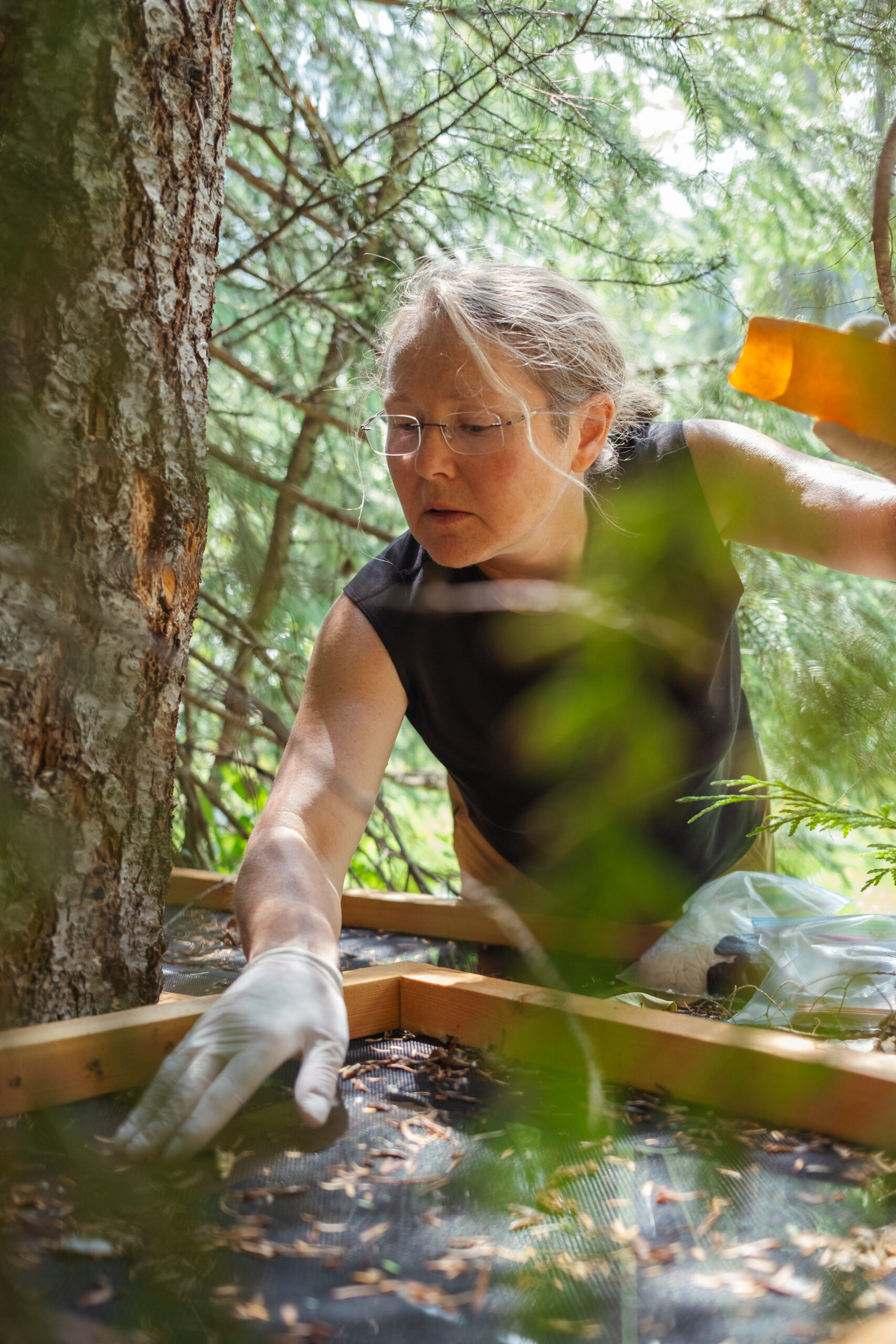
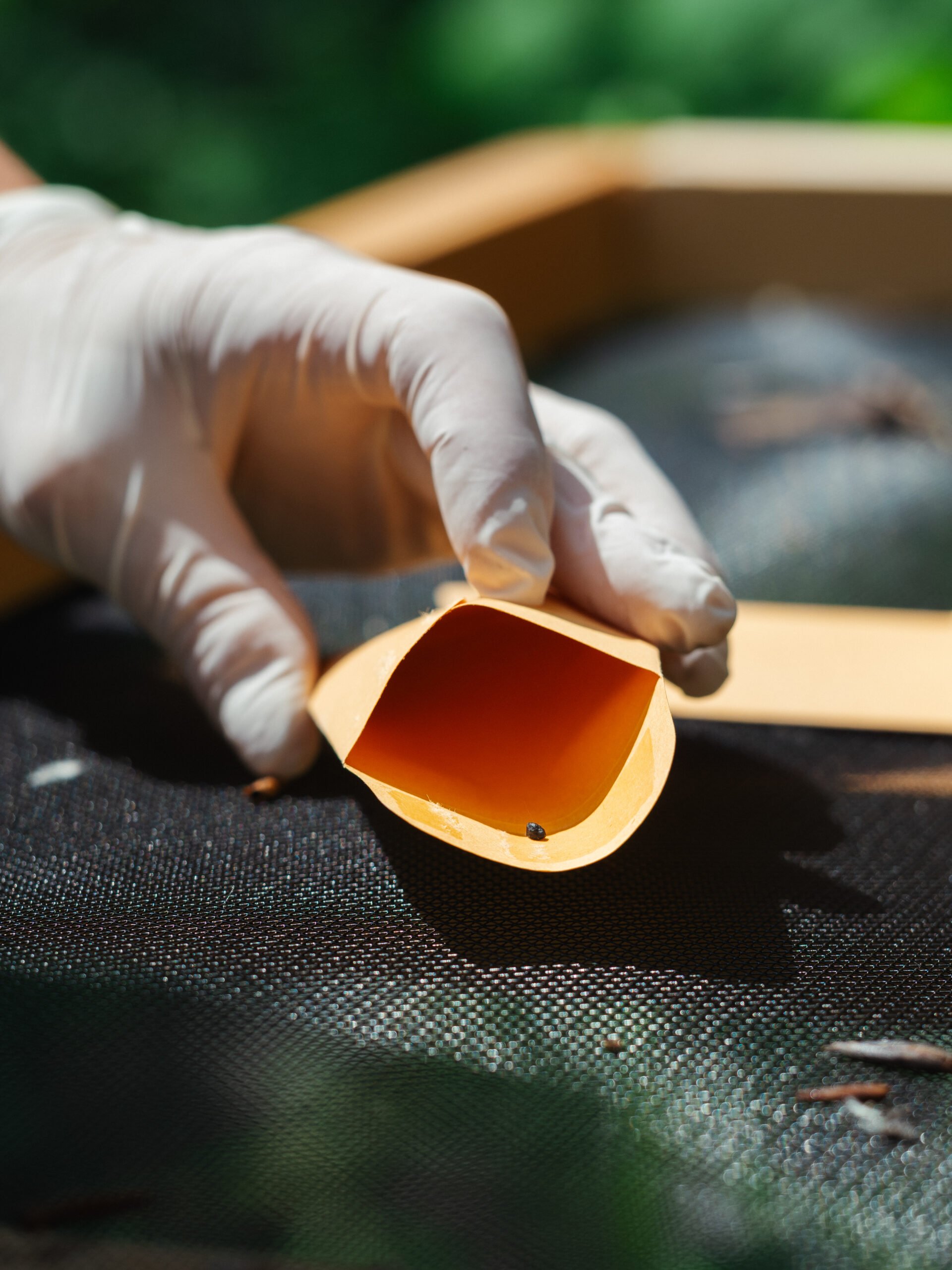
Efforts to help northern myotis bats come as scientists warn the planet is in the midst of the sixth mass extinction event. Close to one million species are at risk of extinction, many within decades, according to a landmark global study that points to habitat destruction as a major culprit. In Canada, more than 5,000 wild species are at some risk of extinction. B.C., the country’s most biodiverse province, officially has more than 1,300 at-risk species. (More than 1,000 additional species meet provincial requirements for listing but have not yet been added, in part because more information is needed.)
B.C. lacks stand-alone legislation to safeguard wildlife, so the vast majority of at-risk species, including northern myotis bats, receive no automatic protections. Canada’s Species At Risk Act only grants automatic protections to wildlife found on federal land — a scant one per cent of B.C. — as well as to migratory birds, fish and marine mammals.
Building fake old-growth trees might have been a nonstarter were it not for the discovery of an endangered Indiana bat maternity colony in a proposed firing range on the Fort Knox, Kentucky, military base. Like northern myotis bats, Indiana bats are tiny — they have pink lips and mouse-like ears — and typically roost under the sloughing bark of older trees. The U.S. Department of Defense turned to Replications Unlimited, one of the leading producers of artificial outdoor scenery for American zoos, parks and displays, which modified an existing plastic product called Flex-Bark. The company added wire mesh to allow bats to grip and hang from the undersurface, calling the new product BrandenBark after a military base biologist whose last name was Branden.
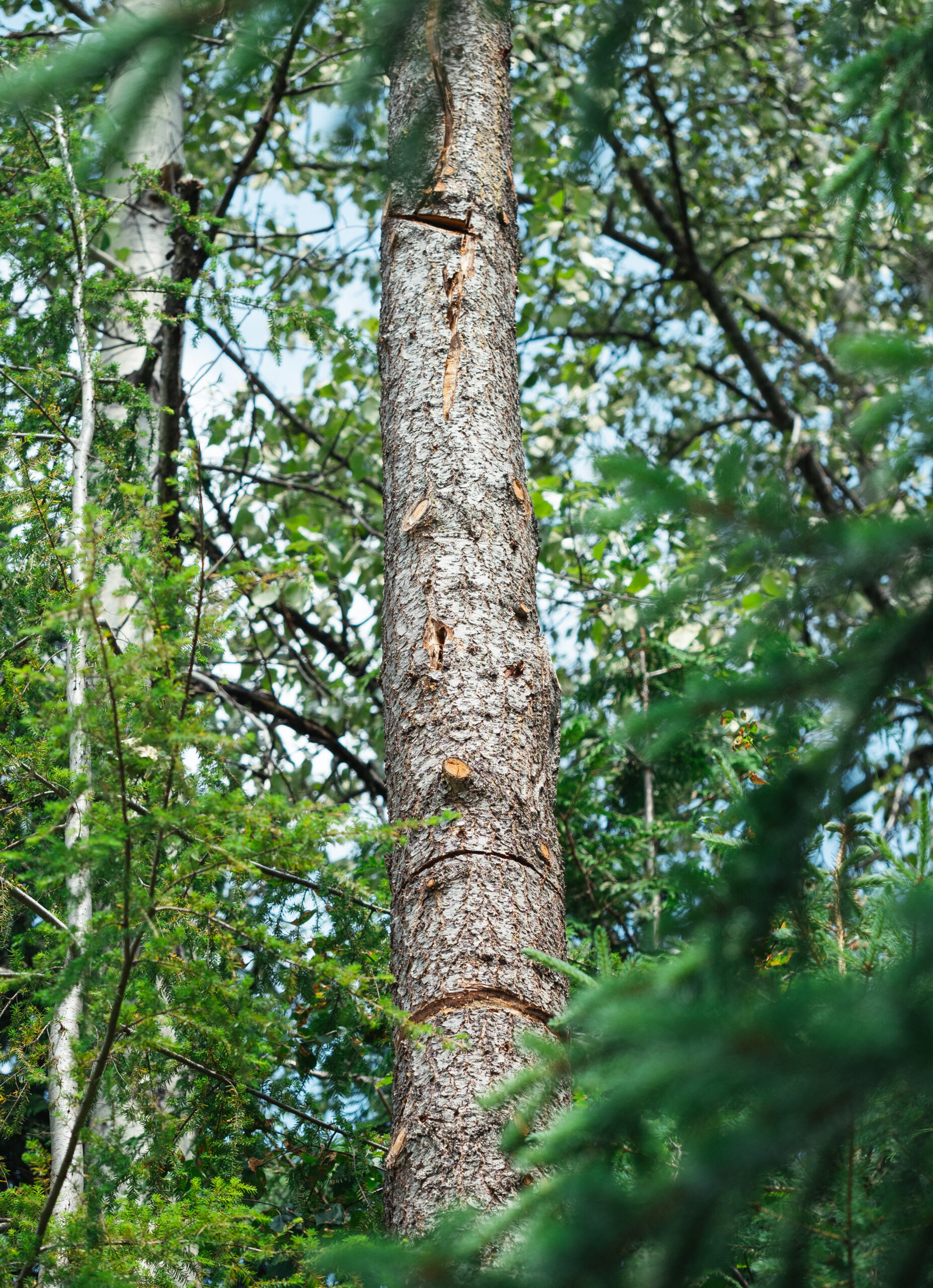
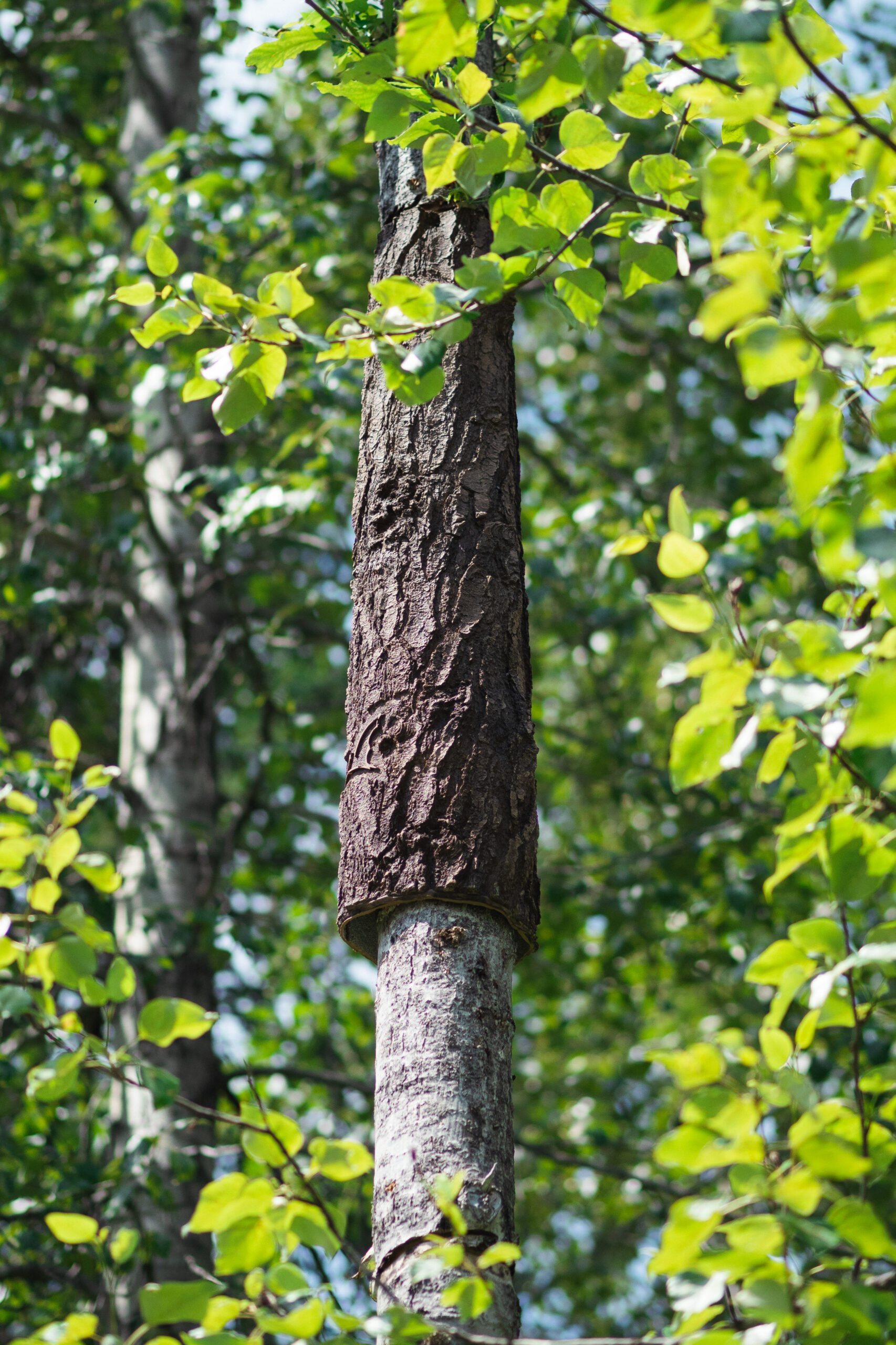
In Kentucky, a team fastened BrandenBark to poles, leaving just enough room at the bottom for the bats to squeeze in. Less than two months later, Indiana bats were documented using the fake trees. A three-year study found the bats, dispossessed of their natural roosting habitat, used the fake bark on a regular basis. Five other bat species also began roosting in the structures, which mimic the microclimate conditions and visual clues of natural bark roosts. Today, the product is used in 19 U.S. states and three Canadian provinces, according to Zachery Baer, a biologist with a U.S. consulting firm that oversaw the creation of the bark.
The Wildlife Conservation Society project paid up to $900 a sheet for the imitation bark, including import duties and taxes. Each tree requires one sheet. “This is not the long-term solution for many reasons,” Lausen observes. “But mostly, at this point, this stuff is way too expensive.”
Lausen doesn’t like to think of a world without bats, a creature more closely related to humans than to mice. Bats have been on the planet for more than 53 million years, long before early humans evolved and made their way out of Africa. They’re the world’s only mammal with powered flight. Some mammals, like flying squirrels, have membranes that stretch from wrist to ankle, allowing them to glide from tree to tree. Bat flight differs from bird flight, with a motion more like swimming than flapping. Their wings, resembling a human hand, have fingers with skin stretched between and a small, protruding thumb for climbing on surfaces after they land. Often dark in colour, they fly at night when humans can’t see, giving rise to myth. Blind as a bat. They will suck your blood. Bats fly into your hair. You’ll get rabies.
Although they’re largely out of sight, bats provide billions of dollars in annual ecosystem services in North America. In southern reaches they fertilize plants and throughout the continent they keep insect populations in check, including agricultural pests and forest pests such as spongy moths and spruce budworm. “When it comes down to a healthy, intact ecosystem, bats are playing a huge role,” Lausen says.
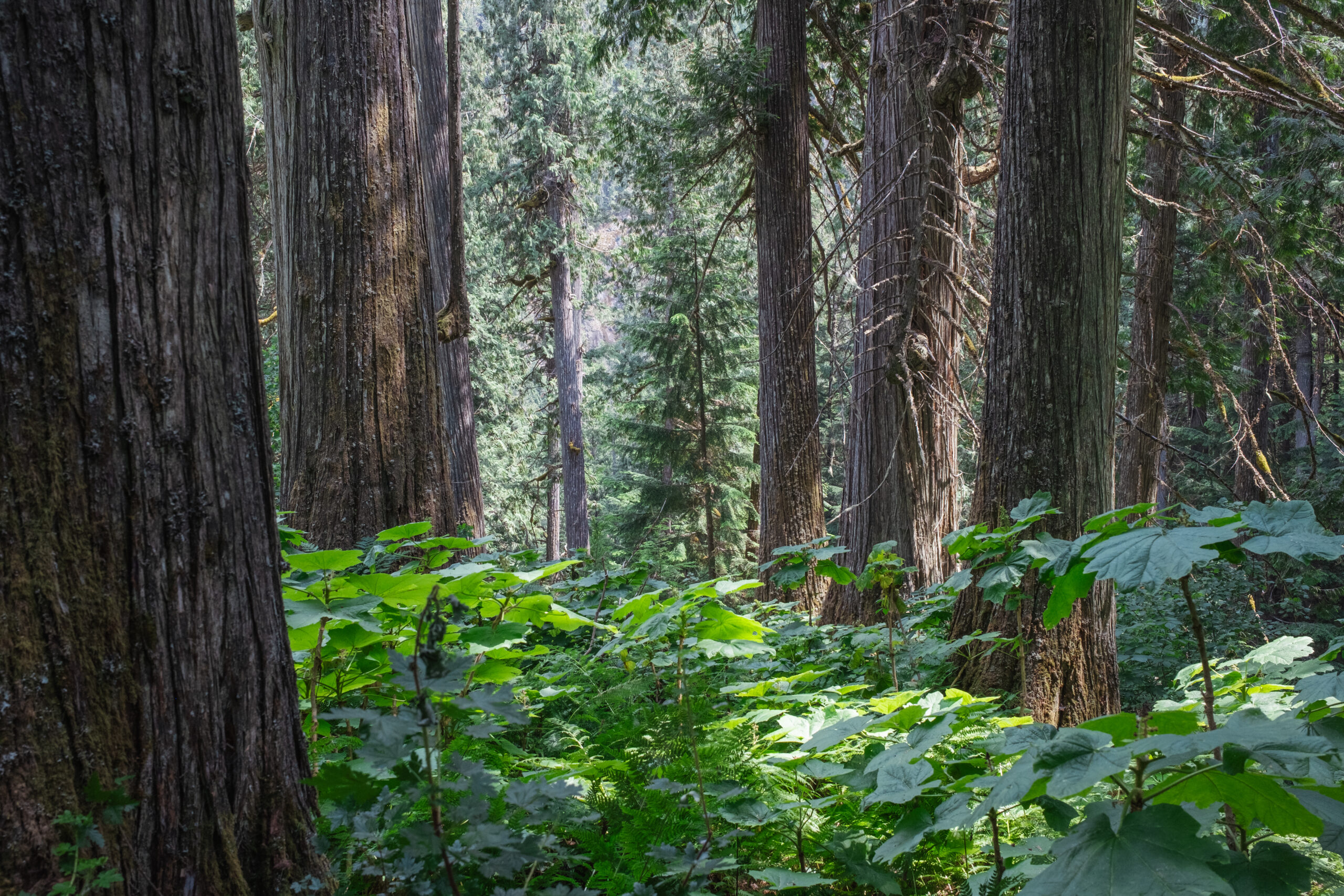
The majority of B.C.’s 17 bat species require old-growth or mature trees, which have appropriate crevice conditions for roosting. Old-growth trees provide a myriad conditions ideal for raising young, and sometimes for hibernating, although bats will also over-winter in caves or mines. “The biggest misunderstanding that most people have is that they look around, they see trees, and they think ‘Okay, well there’s habitat for bats.’ But most bats, and especially ones that are going to produce young, require very specific characteristics in trees, traits that are typically not present in young trees.”
And not just one tree. A northern myotis colony will use up to 60 different roost trees — “really just somewhere where a bat will hang out” — over a summer. Females with young pups have very particular needs. “They need roosts that are usually well insulated, like a big old-growth tree, where it will retain the heat at night, so the pups can continue to grow even though mom’s out feeding and her warm body isn’t right next to them.”
Once the pups start to fly and become independent, females find a roost with the right temperature and humidity to enable them to quickly put on fat before a long winter spent hanging by their toes in torpor, lowering their body temperatures to conserve energy. Sometimes females opt to roost alone, to avoid burning fat to keep their body cool when they are nestled among other colony members. During pregnancy, they choose a warmer nook or crevice. “I call it the Goldilocks approach,” Lausen says. “They need the just right temperatures to successfully raise young and so we need to provide all the options.”
Females return to the same roosting trees over and over again — in some cases, depending on the longevity of the species, for 30 years. If their roosting trees are gone, they search for nearby trees with similar characteristics. When their natal forest has been logged and they can’t find a suitable tree, or expend too much energy hunting for one, they’re likely to die. Bats are so small they lose water and warmth much faster than most mammals.
“You might think that what we’re trying to do is like a big waste of money and kind of crazy,” Lausen says. “I can kind of see that perspective, to step back and look at it that way. Right here, we’ve got three BrandenBark roosts and three wildlife roosts. So basically we provided six roosts, and I’m just telling you now that they need 60. So we’re not giving them everything they need.”
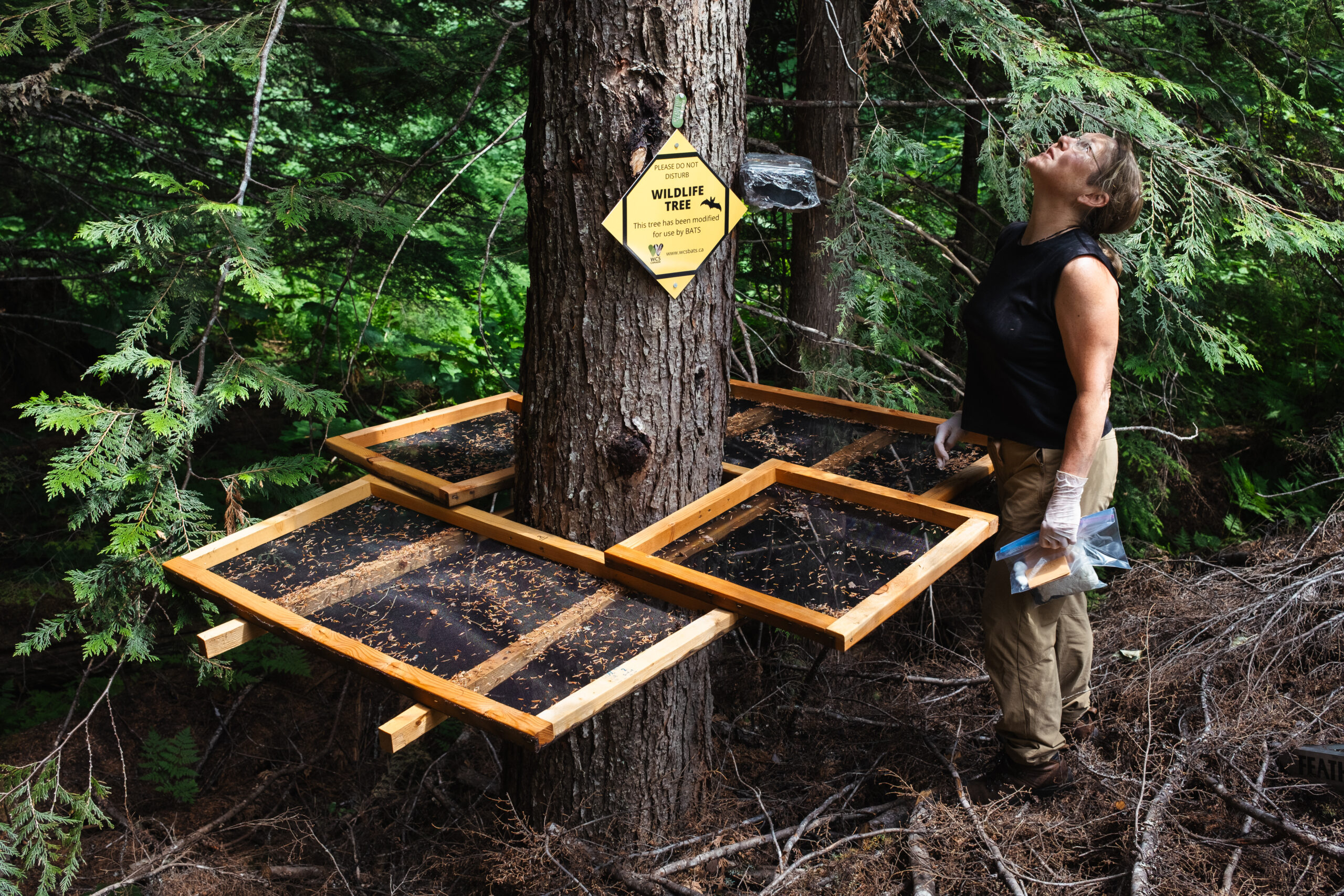
The modified trees are an essential component of a larger plan to create corridors for northern myotis bats and other wildlife dependent on old-growth trees, she explains. Lausen and her team are part of the Kootenay Connect project, which aims to create ecological corridors linking wildlife habitats, biodiversity hotspots, protected areas and climate refugia.
Researchers chose the clearing near Beaton because it’s only a few hundred metres from five ancient cedars near the banks of the Incomappleux River, all that’s left of the inland temperate rainforest in the area. Cedars don’t have the type of bark under which the bats can crawl, but old cedars have roost cavities made by woodpeckers. The clearing is also a short distance from a privately owned grove of ancient cedars where northern myotis bats roost. (The bats can fly about 25 kilometres in a night, one way.)
And it’s bat-flying distance from the recently protected Incomappleux Valley, the largest tract of old-growth inland temperate rainforest left in the region, making it a likely home for northern myotis and other bats. “What we’re trying to do is figure out places where bats might be commuting and need these routes. … We’re kind of looking at these in terms of corridors for these animals to be able to move across the landscape and not have to make these giant leaps where there’s actually no place for them to roost if they need to,” Lausen says.
To that end, the team also installed BrandenBark on six other trees in two locations nearby. Lausen checks the trays on the trees for guano but doesn’t find any.
She says it’s too early to tell if the fake old-growth trees are helping northern myotis bats in the inland temperate rainforest. But as she searches for rice-sized guano, Lausen also doesn’t want to lose sight of the bigger picture for the bats here. The “number one solution,” she says, is “don’t cut the trees down in the first place.”
Get the inside scoop on The Narwhal’s environment and climate reporting by signing up for our free newsletter. On a warm September evening nearly 15...
Continue reading
From disappearing ice roads to reappearing buffalo, our stories explained the wonder and challenges of...

Sitting at the crossroads of journalism and code, we’ve found our perfect match: someone who...

The Protecting Ontario by Unleashing Our Economy Act exempts industry from provincial regulations — putting...
